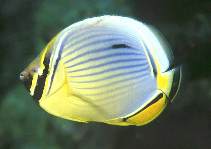| Family: |
Chaetodontidae (Butterflyfishes) |
| Max. size: |
15 cm TL (male/unsexed) |
| Environment: |
reef-associated; marine; depth range - 30 m |
| Distribution: |
Indian Ocean: from East Africa and islands of western and central Indian Ocean to Andaman Sea, Cocos-Keeling Islands, Christmas Island, and western Indonesia (western Sumatra, Java, Bali ad Nusa Penida).. According to Randall, pers. comm. 1995 Chaetodon trifasciatus occurs only in the Indian Ocean while Chaetodon lunulatus occurs only in the Pacific). DNA (from tissue samples) expected to further distinguished two distinct species (Chaetodon lunulatus and Chaetodon trifasciatus (Ref. 86689). |
| Diagnosis: |
Dorsal spines (total): 13-14; Dorsal soft rays (total): 20-22; Anal spines: 3-3; Anal soft rays: 18-21. Description: Body pale orange, dorsally and posteriorly blue, diagonal stripes nearly horizontal, purple; eye bar black, margin yellow; anal fin bar black, margin yellow, base reddish; caudal fin base also reddish. Distinguished by the orange caudal peduncle (Ref. 48636). Tip of caudal fin is transparent (Ref 4855). Snout length 3.3-4.4 in HL. Body depth 1.5-1.8 in SL (Ref. 90102). |
| Biology: |
Occur in coral-rich lagoons and semi-protected seaward reefs. Territorial and aggressive to other Chaetodon. Small juveniles secretive in corals (Ref. 48636). Swim in pairs. Feed exclusively on coral polyps, particularly of the Pocillopora type (Ref. 5503, 48636). Oviparous (Ref. 205), monogamous (Ref. 52884). Form pairs during breeding (Ref. 205). |
| IUCN Red List Status: |
Least Concern (LC); Date assessed: 07 October 2009 Ref. (130435)
|
| Threat to humans: |
harmless |
Source and more info: www.fishbase.org. For personal, classroom, and other internal use only. Not for publication.
